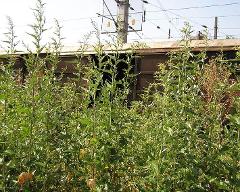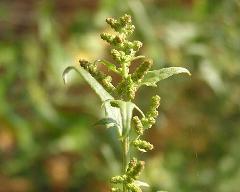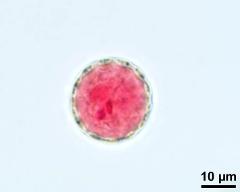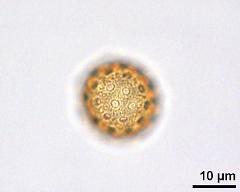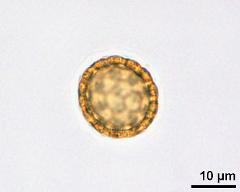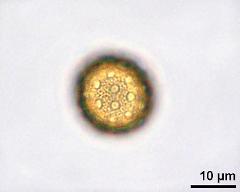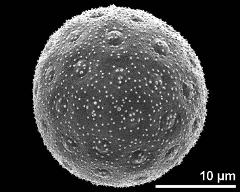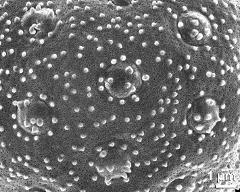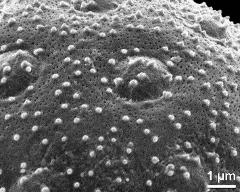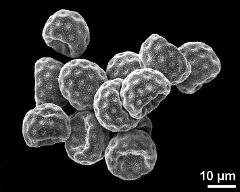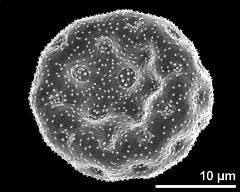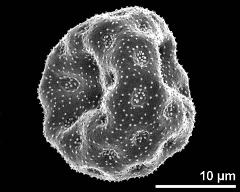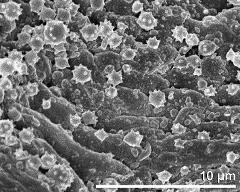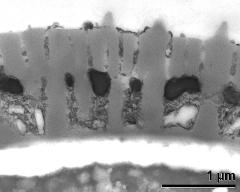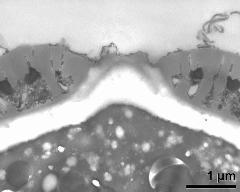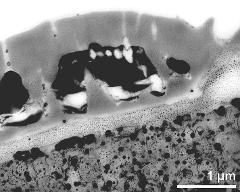Atriplex sagittata
Taxonomy: Angiospermae, Caryophyllales, Amaranthaceae, Atriplex
Published: 2016-07-25
Pollen Description
Shape, Size and Aperture
pollen unit: monad, dispersal unit and peculiarities: monad, size (pollen unit): small (10-25 µm), size of hydrated pollen (LM): -, shortest polar axis in equatorial view (LM): -, longest polar axis in equatorial view (LM): -, shortest diameter in equatorial or polar view (LM): -, longest diameter in equatorial or polar view (LM): -, pollen class: porate, polarity: isopolar, P/E-ratio: -, shape: spheroidal, outline in polar view: circular, dominant orientation (LM): -, P/E-ratio (dry pollen): -, shape (dry pollen): cup-shaped, outline in polar view (dry pollen): no suitable term, infoldings (dry pollen): no suitable term, aperture number: >6, aperture type: porus, aperture condition: pantoporate, porate, aperture peculiarities: aperture membrane ornamented, pantoaperturate
Ornamentation and Structure
LM ornamentation LM: scabrate, nexine: -, sexine: -, SEM ornamentation SEM: perforate, microechinate, suprasculpture SEM: -, TEM tectum: eutectate, infratectum: columellate, foot layer: continuous, endexine: absent, intine: monolayered, wall peculiarities: -, supratectal element: -
Miscellaneous
pollen coatings: primexine matrix, pollenkitt, reserves in cytoplasm: starch, cell number: 3-celled, Ubisch bodies: present
Author(s) of diagnosis: Sam, Saskia
Pictures
Picture legend
- habitus, photographer: Sam, S.
- flower(s), photographer: Sam, S.
- vegetative nucleus and sperm cells - fresh, unfixed, aceto-carmine, photographer: Sam, S.
- upper focus - fresh, acetolyzed, unstained, photographer: Sam, S.
- optical section - fresh, acetolyzed, unstained, photographer: Sam, S.
- lower focus - fresh, acetolyzed, unstained, photographer: Sam, S.
- hydrated pollen grain - fresh, rehydrated (water) & critical point dried & sputter coated with gold, photographer: Sam, S.
- exine surface and apertures - fresh, rehydrated (water) & critical point dried & sputter coated with gold, photographer: Sam, S.
- apertures - fresh, rehydrated (water) & critical point dried & sputter coated with gold, photographer: Sam, S.
- dry pollen grains - dry, sputter coated with gold, photographer: Sam, S.
- dry pollen grain - dry, sputter coated with gold, photographer: Sam, S.
- dry pollen grain - dry, sputter coated with gold, photographer: Sam, S.
- anther wall with Ubisch bodies - fresh, rehydrated (water) & critical point dried & sputter coated with gold, photographer: Sam, S.
- interapertural area of pollen wall - fresh, glutaraldehyde & osmium & potassium ferrocyanide, modified Thiéry-test, photographer: Sam, S.
- apertural area of pollen wall - fresh, glutaraldehyde & osmium & potassium ferrocyanide, modified Thiéry-test, photographer: Sam, S.
- pollen wall at transition of aperture and interapertural area - fresh, glutaraldehyde & osmium & potassium ferrocyanide, lipid-test, photographer: Sam, S.
Literature
- (1994) Exkursionsflora von Österreich : 1180
- (1998) Preparing living pollen material for scanning electron microscopy using 2,2-dimethoxypropane (DMP) and criticalpoint drying. Biotechnic Histochem 73: 137–143
Copyright and Citation
Cite this publication as:
Sam S. 2016. Atriplex sagittata. In: PalDat - A palynological database. https://pc8.botanik.univie.ac.at/pub/Atriplex_sagittata/301257;jsessionid=D81296F66A5DCC80295D001FC9AC44B9; accessed 2025-01-10

